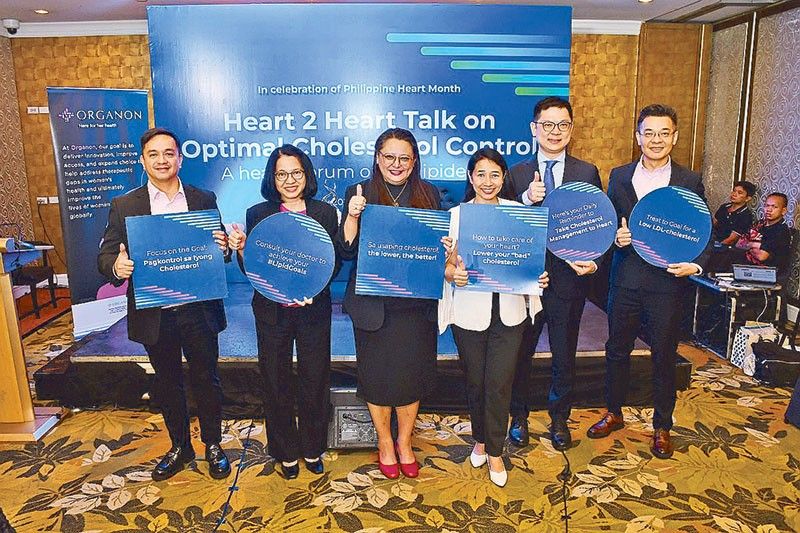Why you should take cholesterol control to heart
Just because you’re skinny doesn’t mean you’re healthy. While there are higher risks for heavier people, thinner individuals are not immune to health issues, particularly heart diseases, diabetes, and dyslipidemia. “Remember, your physique doesn’t dictate what your health ‘numbers’ — blood pressure, blood sugar and cholesterol levels — are,” reminds Dr. Louella Santos, president of […]


Just because you’re skinny doesn’t mean you’re healthy. While there are higher risks for heavier people, thinner individuals are not immune to health issues, particularly heart diseases, diabetes, and dyslipidemia.
“Remember, your physique doesn’t dictate what your health ‘numbers’ — blood pressure, blood sugar and cholesterol levels — are,” reminds Dr. Louella Santos, president of the Philippine Lipid and Atherosclerosis Society (PLAS).
While some of us are familiar with cardiovascular diseases and diabetes, very few know what dyslipidemia is.
“Having dyslipidemia means that there’s something wrong with your cholesterol levels,” Dr. Santos explains. “And when we talk about cholesterol, it’s a summation of different components.”
Total cholesterol is a breakdown of three components in your fasting lipid profile: triglycerides, good cholesterol (HDL or high-density lipoprotein), and bad cholesterol (LDL or low-density lipoprotein).
“A lot of people get confused with triglycerides,” observes Dr. Santos. “Triglycerides are the fat that you get out of whites — white rice, bread, pasta and potatoes.”
Good cholesterol (HDL) helps eliminate bad cholesterol in the body. We get it from fish, nuts, and regular exercise. Bad cholesterol (LDL), which one gets mostly from red meat and processed food, is bad for the body.
“If your triglyceride level is high, that’s what we call dyslipidemia,” explains Dr. Santos.
Simply put, dyslipidemia refers to abnormal, unhealthy levels of cholesterol in the body. When too much bad cholesterol circulates in the blood, it causes build-ups of fatty plaques along the walls of your arteries, which can clog and disrupt the normal blood flow to the heart.
Cholesterol control and heart health
If dyslipidemia is left unchecked, this could lead to debilitating and fatal conditions like heart attack, stroke, and other severe complications.
“Cardiologists are fixated on cholesterol control because we believe that doing so could prevent cardiovascular diseases,” explains Dr. Santos during the “Heart 2 Heart Talk on Optimal Cholesterol Control” held recently at the Mactan Ballroom of Edsa Shangri-La Manila.
Organized by healthcare company, Organon Philippines, the talk is aimed at raising awareness about effectively managing dyslipidemia and how Filipinos can protect their heart from the long-term impacts of high-cholesterol levels.
Dr. Santos was joined by Dr. Myla Gloria Supe, cardiologist; Dr. Pipin Kojodjojo, cardiologist from Singapore; Desmond Ho, associate director for marketing, Organon Southeast Asia; and Emmanuel Tiglao, country director, Organon Phils.
Recent statistics from the Philippine Statistics Authority (PSA) have shown that heart disease accounts for 124,182 cases or more than 18 percent of all deaths across the country, claiming more lives than any other illness.

Alarmingly, the data reveals that millions of Filipinos as early as 20 years old are unknowingly suffering from high cholesterol levels, which put them at even higher risk for developing a heart disease.
According to the 8th National Nutrition Survey, one out of every two Filipinos have borderline high cholesterol levels, making dyslipidemia a hidden public threat in young adults and people who are at the height of their career.
What’s interesting to note is that Filipinos in general have low HDL (good cholesterol) and high triglycerides.
“We’re not sure if it’s genetic or having low HDL is something Filipinos have inherently,” notes Dr. Santos. “Add to that, our main staple is white rice. And so, if we don’t modify our diet, we’re building a nation of patients with insulin resistance, diabetes, and heart diseases.”
Who are vulnerable?
Chronic stress, poor lifestyle habits like smoking and drinking, and inactivity increase cholesterol levels even in people in their 20s and 30s. And since dyslipidemia shows no clear symptoms at first, many young adults remain unaware of the silent damage accumulating in their arteries over time.
“Patients with dyslipidemia don’t feel anything. There are no symptoms, unlike high blood pressure. And a lot of Filipinos don’t even bother checking their lipid profile. They don’t know what numbers they should go after,” Dr. Santos adds.
And so, regardless of age, physique or family history, getting a complete cholesterol test is critical to optimizing health and catching high cholesterol early.
So when’s the best time to have your cholesterol checked?
“In patients with no risk factor, meaning, no family history of stroke or heart attack, and diabetes, the recommended age for screening is 45 years old. That means at 45, you should get a yearly lipid profile regardless of symptoms,” explains Dr. Santos. “Those with known risk factors should talk to their doctors and see if there’s an indication to get an early lipid profile screening.”
Finding the shoe that fits
As a preventive cardiologist, Dr. Santos says that diet and lifestyle modifications are cornerstones in treating dyslipidemia.
“But sometimes when diet and lifestyle modifications are not enough to manage their LDL, we do have to resort to medical therapy. For patients who already had an episode — a heart attack or stroke — we need to aggressively lower their LDL levels with meds to push their numbers down. There are new molecules that are being developed now where they combine medications in a single pill for ease of compliance,” explains Dr. Santos.
Cholesterol-lowering drugs include statins, cholesterol absorption inhibitors, and PCSK9 inhibitors, among others.
“When we talk about LDL, your goal is dependent on your risk. Every person will have a different goal. Understand that in treating LDL, it’s finding the shoe that fits. That’s why it’s important to have your lipid profile interpreted by your doctor,” adds Dr. Santos.
Also, staying faithful to your medication routine and taking cholesterol control to heart could save you and help you live a more fulfilling life free from complications.














